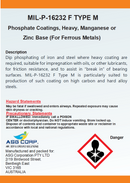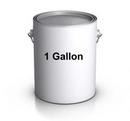Product Information
Description
Dip phosphating of iron and steel where heavy coating are required, suitable for impregnation with oils, or other lubricants, for friction resistance, and to assist in “break in” of bearing surfaces. MIL-P-16232 F Type M is particularly suited to production of such coating on high carbon and hard alloy steels.
GOVERNMENT SPECIFICATIONS APPLICABLE
MIL-P-16232 F Type M conforms to the following specifications:
MIL – P – 16232 B, Type M, Classes 1,2,3,4
MIL – P-50002, Type I, Composition B
we also offer classes 1,2,3
Application
Preparation of Steel Surface: Surfaces may be cleaned by abrasive blasting prior to the use of MIL-P-16232 F Type M, except for those cases where blasting may be deemed detrimental by the contracting officer, or is waived for other reasons by proper authority. In any event, the metal surface must be subjected to such non – detrimental cleaning and conditioning procedures as are necessary to insure satisfactory phosphating.
When alkaline cleaners are to be used, we recommend our product MIL-C-13924 C at a concentration of 4 to 6 oz / gallon and a temperature of 160 – 190˚F. Cleaning must be such that no water break is observed when parts are held under running water. Parts must be thoroughly rinsed in clean water after each liquid cleaning or conditioning operation. Water rinses must be kept pure by steady overflow into weir troughs. Rinse tanks are to be dumped and refilled daily.
Where rust and /or scale are to be removed by chemical means, we recommend our product ATAROL a phosphoric acid type conditioner, otherwise sandblasting is recommended.
Phosphating: The phosphating bath is made up by addition of 9 to 11 gallons MIL-P-16232 F Type M to each 100 gallons clean water. To shorten break-in period, add several pads of steel wool for each 100 gallons bath; this break-in substance is to be used at the start only. Stir, and then heat to operating temperature range.
Immerse the clean parts in the bath at 200-210˚F. for a sufficient length of time to produce the coating required by the specifications. Ordinarily this will be for not less than 10 minutes, or more than 30 minutes.
Water is to be replaced as it evaporates from the bath. Most of sludge should be removed from tank at one week to ten-day periods. The bath need be discarded seldom, if ever, provided it is properly cared for and closely as provided below.
Water Rinse After Phosphating: The phosphating parts are to be immediately rinsed in cold or lukewarm clean, overflowing water bath, for not less than 60 seconds.
Final Chemical Rinse: As a final processing step immediately before dry-off, the parts are rinsed for not less than 30 or more than 60 seconds in a bath made up with our product HIB, 2- 3 o/oo in water and used at temperature 140 – 180 ˚F. This rinse must be carefully maintained and controlled according to the Phosphat standard chromic rinse control instructions, copy attached.
If a non chromate type inhibitive rinse is required because of government restrictions, use HIBI SEAL-NC(non-chromate). The parts are rinsed for not less than 30 or more than 60 seconds in a bath made up with our product HIBI SEAL- NC, 2-5 o/o in water and used at temper
The following test is at 4-hour intervals on Phosphat tank:
- Take 5 ml. sample of bath. Add 50 ml. distilled water.
- Add 3-4 drops M.O. (methylorange) indicator.
- Add N/10 sodium hydroxide solution until color changes to amber, recording number ml. used as “M.O end point.”(FREE ACID)
- Add 5 drops phenolphthalein indicator to same sample.
- Continue to add sodium hydroxide solution until colour changes to pink, recording total number ml. used as “phenolphthalein end point ” (TOTAL ACID).This includes that used for M.O. point.(paragraph 3)
- Maintain total acid at range 30-40
- Maintain “acid ratio” at range 5.5-9.5.
ACID RATIO TOTAL ACID
FREE ACID
FERROUS IRON CONTROL
Maintain iron in the solution from 1000-5000 ppm. If iron is excessive (more than 5000 ppm ), add small amounts of ACCEL to reduce iron to the above limits.
Payment & Security
Your payment information is processed securely. We do not store credit card details nor have access to your credit card information.





